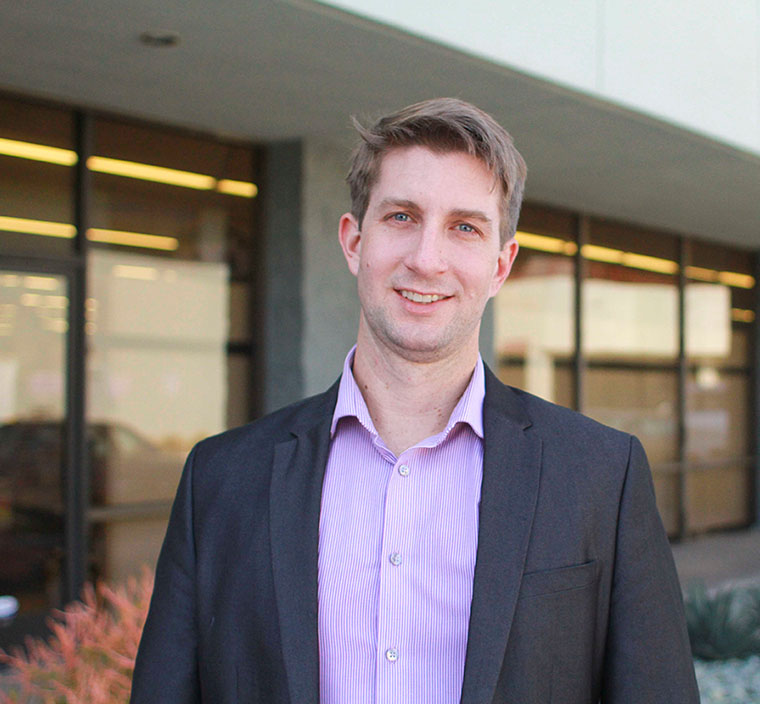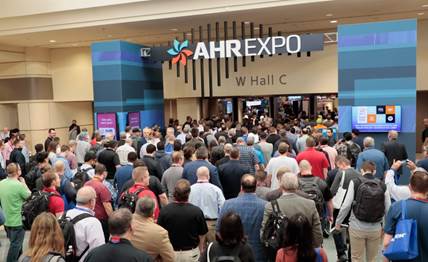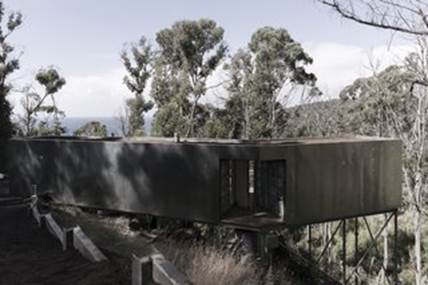|
April 2021
AutomatedBuildings.com
|
[an error occurred while processing this directive]
(Click
Message to Learn More)
|
|
“The Only Constant is Change”
Virtual reality is just not quite the same as the real deal, but in
alignment with this month’s publication theme “Adaption”
|
Phillip Kopp, CEO Conectric Networks
https://conectric.com/
|
 It’s been well over a year now since
I attended the AHR Convention in Orlando, in what would be my last in person
conference experience. Shortly after AHR, Ken Sinclair invited me to write a
couple of articles related to his series on Wireless Ways, in
which we discussed retrofitting wireless IoT sensors to make buildings more
flexible and adaptable to changing and dynamic conditions (“What does Yoga have
to do with building systems” April, 2020 edition). Little did we
know what the pandemic future was holding at the time…
It’s been well over a year now since
I attended the AHR Convention in Orlando, in what would be my last in person
conference experience. Shortly after AHR, Ken Sinclair invited me to write a
couple of articles related to his series on Wireless Ways, in
which we discussed retrofitting wireless IoT sensors to make buildings more
flexible and adaptable to changing and dynamic conditions (“What does Yoga have
to do with building systems” April, 2020 edition). Little did we
know what the pandemic future was holding at the time…
Needless to say, a lot has changed
since then. Although I didn’t get to go to any other conferences during the
last year, I sure have spent a lot of time on Zoom and other virtual meeting
platforms. Virtual reality is just not quite the same as the real deal, but in
alignment with this month’s publication theme “Adaption”, I have actually learned
to adapt.
In fact, with this new virtual world my
company is getting some of the best marketing results ever. Probably better
than any of the hundreds of in-person events I have spent ungodly sums to
attend over the last 20 years. Now we can actually collect empirical market
intelligence and learn more about what is driving captive decision makers
during virtual webinars. A practical step up from piles of business cards,
chicken scratch notes and anecdotal conversations remembered foggily after a
few too many vendor sponsored adult beverages. It turns out you don’t have to
embarrass yourself in a karaoke bar at 2AM to close deals after all (I’ve
personally been on the wrong side of that debate more than once before...).


OLD
NEW
Before
2020 conferences were about good times with good people. But with virtual
conferences and webinars we now get hard data that can directly inform business
decisions.
Humans are very good at adapting and that
is likely an underlying reason for our success as a species so far. But what
about our assets? All of the physical systems we have designed to help us in
our quest to survive in our dynamic Earth home and propagate out into the rest
of the Universe. In particular, those buildings we have developed in order to
live in all types of conditions and climates around the world (and space… in
the not-so-distant future). Arguably one of the oldest and most important adaptation
tools in our inventory. Are our buildings adaptable to the constant change?
What if the environment they were built to endure changes around them? What if
the end-use they were designed for is no longer relevant? Just for example, all
those giant convention facilities and office buildings that have been empty for
over the last year. These are very important questions for the owners,
operators and users of those very costly assets.

Retail
shopping malls were already being abandoned prior to the pandemic. Imagine what
happens next? (Image source)
In researching material for this piece,
I came across an interesting National Geographic educational article titled Adaptation and
Survival (accessed 3/23/21, no author cited).
The article describes that there are actually two distinct types of adaptation:
Structural and Behavioral. It goes on to explain that Structural adaptation is
when the physical structure of an organism adapts over time to better suit its
environment. For example, plants that live in extremely wet or dry climates
have different structural attributes for storing water. Behavioral adaptation
on the other hand, is when an organism changes the way it reacts to changing
conditions, even if its underlying structure remains the same. For example, the
migration of animals from North to South during different seasons of the year.
I believe this has a lot of relevance
to the current discussion on how to adapt our countless building assets to keep
up with the faster and faster pace of change. Not only have we seen drastic
changes in building occupancy and potentially end uses over the last year, but
also a more systemic and long-term impact they have on the globally accepted
need to act more sustainably towards our environment. Especially with the
dramatic increase in electricity expected to be used by buildings in emerging
economies, probably exceeding OECD
countries during the next few years.
Let’s look first into the structural
component of how our buildings will need to adopt to these new paradigms. It is
not only possible, but necessary to rethink how we design and build in the
future to make our structures more adaptable and resilient to changing
conditions. However, the reality is that our entire industry is not well suited
to this kind of sudden, major change either. This begs a kind of reengineering
of the entire industry stack. From how stakeholders like engineers, architects,
technicians, builders and consultants are trained and deployed, to how
buildings are financed and later operated. Building a structure to meet a
specific end use makes it inherently inflexible. This can be closely tied to
local zoning ordinances and master planning that require certain types of
structures to be built in certain areas. The expected use of an asset over its
life facilitates financing its development. But what if needs change so
dramatically that a once a busy shopping mall dies, and must be repurposed as a
corporate office campus or a multi-family complex? With cities in drastic need
to build resilience to extreme weather and public health or safety crisis, it’s
very likely we will see a rethinking of these zoning systems in the coming
future to facilitate new kinds of multi-purpose buildings. And with those buildings, a new kind of
construction process which de-emphasizes the importance of any particular
stakeholder during early construction and adds much more value in providing
ongoing services to these adaptable structures, which may be in constant change
over their entire useful life. This is a fundamental shift in the distribution
of resources across an entire industry, including how buildings will be owned
and operated.


Could
this Australian pivoting container building be a window into our future
adaptable modular buildings that can be easily changed over time? (Source
article: dwell.com)
Although these concepts may be
somewhat further into the future, there is a very real current opportunity to
adapt behaviorally, as nature does in response to changing conditions. While
many existing buildings may not be able to adapt structurally, it is still
possible to implement behavioral changes that result in a more adaptable
facility. These kinds of behavioral adaptations are virtually guaranteed given
the effects of the pandemic on our ability to occupy buildings safely. This is
highlighted by the need to ensure that indoor spaces are healthy to be in,
interactive, optimized and environmentally sustainable. If not, it may be
difficult to imagine a complete reoccupation of our major commercial, retail
and event centers anytime in the near future. This is a transformation we will
see in a massive scale over a very short period.
This kind of behavioral adaption
mimics the current industry conversations on intelligent buildings, data
aggregation and integration of static building systems using smart cloud
platforms, wireless IoT sensors that monitor real-time conditions and
environmental reporting. Transparent real-time information, automation of
buildings systems and enhanced occupant interactivity can allow a safer, faster
and more efficient reoccupation of buildings. Through my vantage point as the
CEO of a technology vendor providing these kinds of services (disclaimer: I am
currently the CEO of Conectric Networks), I do
feel a strong sentiment that technology will lead the short-term adaptation to
the tremendous changes in social and health protocols. Until now, real examples
of these kinds of dynamic building services designed to bring the building and
occupants together were few and far between. This was mostly due to the perceived
high cost and complexity of implementing them. The cost is continuously coming
down however, and the will to ensure continuous occupation by portfolio owners
is tremendous. Although technology may play a major role in upgrading our large
buildings to adapt to post-pandemic conditions, there is also an important
human element. Having participated in numerous smart building projects, I find
that it is often the human stakeholders which are not able to adapt quickly
enough to these sweeping updates.


The
“Edge” Smart Building Amsterdam
Room utilization with Conectric IoT sensors on Facilio
platform
The
“Edge” building in Amsterdam is largely considered one of the most adapted
intelligent buildings in the world making extensive use of design and
technology to deliver optimum services to occupants (source: buildup.eu)
A very important part of the adaption
process will revolve around the operational staff managing buildings who
perceive these initiatives as minimizing their importance, and the OEM vendors
whose expensive equipment and service contracts may become less relevant. I see
these as the two biggest barriers to enable behavioral adaptions in buildings
facilitated by technology. The reality is that asset owners are more than happy
to make the investments needed to shield their existing portfolios from future
risk, and tenants and occupants who demand a more sustainable, transparent and
healthier indoor environment will not only embrace, but demand that buildings
are able to provide these services. At the end of the day, if a building can
proactively inform service requirements, and more data can be pulled out with
inexpensive wireless sensors, an expensive annual service contract for a
bespoke automation system is not so important anymore. You can be sure there
will be plenty of resistance to this change from the automation industry itself,
unless they too can adapt to offer new business models and technologies.
I have worked with several modern
overlay platforms that provide functions like automated fault detection, vendor
ticketing (CMMS) automation, dynamic occupancy utilization, energy optimization
and building health reporting. These platforms may reduce the need to have
wrenches circulating the property and engineers putting out fires constantly
with manual system adjustments. However, for the most part will still require
trained operators to manage them effectively, optimize settings and get real
eyeballs to diagnose potential problems using decades of field experience that
a piece of software may not have yet. We will still need to install and
commission these systems to ensure they are functioning properly, and they will
still inform future needs to keep the asset functioning optimally which will
require new services and installations. Perhaps even repurposing a building use
several times over its life.
There can be no argument that change
is constant. Our species, like every species must be successful at enduring
these changes by adapting to them. And there is no question that we have seen
very substantial changes in our environment and society over the last year.
Everything from how we eat, to how we meet. As a core part of civilization, our
built environment must also adapt to these changes, both structurally in the
long term and behaviorally in the near term. But in the end, it will be the
people that touch those buildings which must accept and ultimately leverage
those adaptations to their own best interests. I believe we will see a
substantial push for these changes taking place over the next one to three
years by occupants and owners. As a part of this transition, we will surely
learn and explore many new skills, ideas, technologies and behavioral adaptions
which will equip our industry to not only survive the present, but thrive well
into the future.
Please do not hesitate to reach out
to me if this article or others on the subject generate new ideas or questions.
We must all work together towards the ultimate benefit of the industry and our
customers as a team, adapting quickly to changes as they come our way.
footer
[an error occurred while processing this directive]
[Click Banner To Learn More]
[Home Page] [The
Automator] [About] [Subscribe
] [Contact
Us]
 It’s been well over a year now since
I attended the AHR Convention in Orlando, in what would be my last in person
conference experience. Shortly after AHR, Ken Sinclair invited me to write a
couple of articles related to his series on Wireless Ways, in
which we discussed retrofitting wireless IoT sensors to make buildings more
flexible and adaptable to changing and dynamic conditions (“What does Yoga have
to do with building systems” April, 2020 edition). Little did we
know what the pandemic future was holding at the time…
It’s been well over a year now since
I attended the AHR Convention in Orlando, in what would be my last in person
conference experience. Shortly after AHR, Ken Sinclair invited me to write a
couple of articles related to his series on Wireless Ways, in
which we discussed retrofitting wireless IoT sensors to make buildings more
flexible and adaptable to changing and dynamic conditions (“What does Yoga have
to do with building systems” April, 2020 edition). Little did we
know what the pandemic future was holding at the time…





